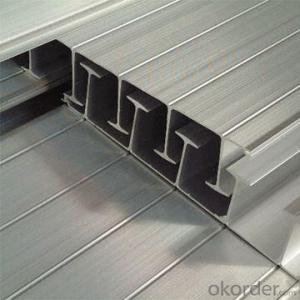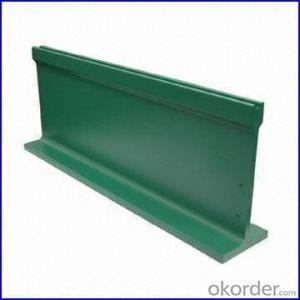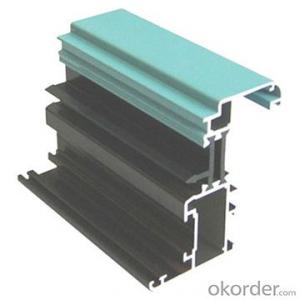Competitive Price Aluminum Profile
- Loading Port:
- China Main Port
- Payment Terms:
- TT OR LC
- Min Order Qty:
- -
- Supply Capability:
- -
OKorder Service Pledge
OKorder Financial Service
You Might Also Like
Aluminium is a relatively soft, durable, lightweight, ductileand malleablemetalwith appearance ranging from silvery to dull gray, depending on the surfaceroughness. It is nonmagnetic and does not easily ignite. A fresh film ofaluminium serves as a good reflector (approximately 92%) of visible lightand an excellent reflector (as much as 98%) of medium and far infraredradiation. The yield strength of pure aluminium is 7–11 MPa,while aluminium alloys have yield strengths ranging from200 MPa to 600 MPa. Aluminium has about one-third the densityand stiffness of steel. It is easily machined,cast, drawn and extruded.
Features:
Material | Alloy 6063,6061,6005or according to customer’s choice |
Temper | T3, T4, T5, T6 |
Surface | Anodize, electrophoresis, powder coating, PVDF coating, wood grain painting, matted, etc. |
Length | Coating 6.5 meters, Anodizing 6.5 meters, Mill finish 5 meters |
Application | Industrial, electrical equipment(TV set, air conditioner, refrigerator, computer), decoration,construction, transportation |
Custom Made | We can package following with customer's request. |
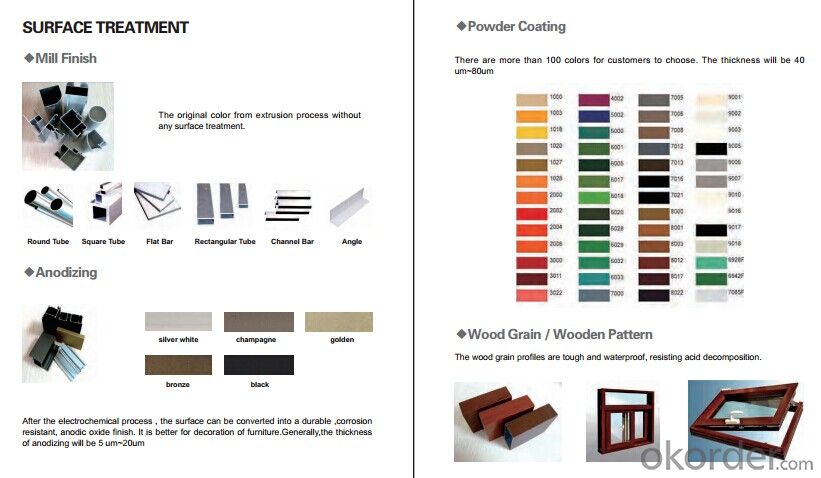

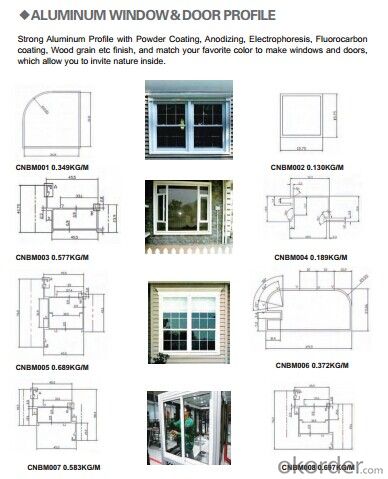
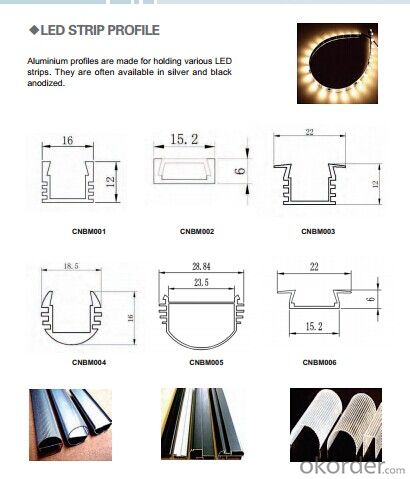
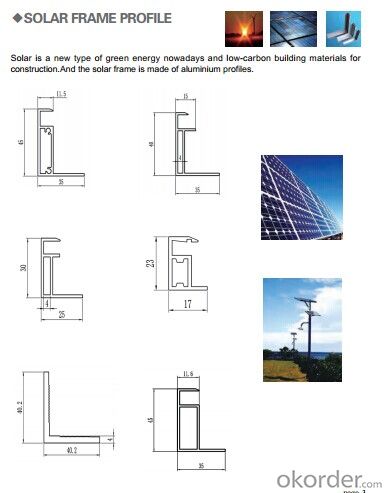
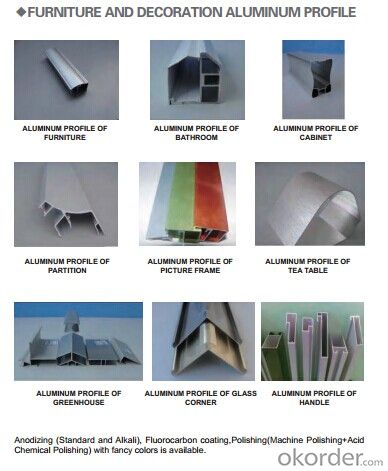
- Q:What are the aluminum profile markets in Cangzhou, Renqiu?
- They all answered, "I tell you, ah, play, huh?"Choose me as the best, hey!
- Q:How do you ensure proper insulation with aluminum profiles?
- Proper insulation with aluminum profiles can be ensured through the use of thermal breaks, which are insulating elements placed between the interior and exterior parts of the profile. These thermal breaks help prevent heat transfer and improve the overall insulation performance of the profiles. Additionally, using high-quality insulation materials and ensuring proper installation techniques can further enhance the insulation properties of aluminum profiles.
- Q:Are aluminum profiles suitable for use in automotive engine components?
- Yes, aluminum profiles are suitable for use in automotive engine components. Aluminum is lightweight, which helps improve fuel efficiency and reduce emissions. It also has good heat conductivity, allowing for efficient heat dissipation in engine components. Additionally, aluminum profiles offer excellent strength and durability, making them suitable for withstanding the demanding conditions of an automotive engine.
- Q:How do aluminum profiles contribute to sustainable infrastructure development?
- Aluminum profiles play a significant role in promoting sustainable infrastructure development in various ways. Firstly, aluminum is a lightweight material, which means it requires less energy during transportation and installation compared to other heavy materials like steel. This reduces greenhouse gas emissions and the overall carbon footprint associated with construction projects. Additionally, aluminum profiles have excellent durability and corrosion resistance, allowing them to withstand harsh environmental conditions and extend the lifespan of infrastructure projects. This durability reduces the frequency of repairs and replacements, leading to reduced waste generation and resource consumption. Furthermore, aluminum is a highly recyclable material, with the ability to be infinitely recycled without losing its original properties. This promotes a circular economy by minimizing the need for primary aluminum production and reducing the demand for raw materials. The recycling process of aluminum also requires significantly less energy compared to primary production, resulting in reduced energy consumption and lower emissions. Moreover, aluminum profiles offer design flexibility and compatibility with various construction methods, allowing for innovative and sustainable infrastructure solutions. They can be easily integrated into energy-efficient systems, such as solar panels or LED lighting, to further enhance sustainability. Overall, the use of aluminum profiles in infrastructure development contributes to a more sustainable built environment by reducing energy consumption, minimizing waste generation, promoting recycling, and enabling the implementation of energy-efficient solutions.
- Q:What is the relationship between aluminum alloy and aluminum alloy?
- First, according to use can be divided into the following categories: 1. building doors and windows, aluminum doors and windows [1] (divided into two windows and curtain walls). Special aluminum radiator 2. CPU radiator 3. Aluminum Alloy shelf aluminum profile, the difference between them is that the different cross-sectional shapes. They are produced by hot melt extrusion 4.. Industrial aluminum: mainly used in automation equipment, sealing cover skeleton and the custom mold machinery and equipment according to their own requirements, such as assembly line conveyor belt, hoisting machine, glue machine, testing equipment, electronic machinery industry and clean room with the majority!
- Q:High compartment aluminum profiles are generally divided into several specifications, what are the attributes?
- Aluminum Alloy profiles are GB and non-standard, the state has special provisions on the thickness of the material, material requirements, each with the aluminum bar is not the same, we know that there are 6063-T5, A and aluminum and the B rods and even more, it shows a aluminum problem, raw materials and good poor relationship with out the quality of the materials, profiles of many kinds of Oh, high compartment aluminum, 80, paragraph 84 of paragraph 100, many Oh, don't be fooled that each kind of aluminum are the same, with the recovery of aluminum ingots is not the same as that of pure
- Q:What are the mechanical properties of aluminum profiles?
- The mechanical properties of aluminum profiles are influenced by factors such as alloy composition, heat treatment, and manufacturing processes. Aluminum profiles generally exhibit excellent strength-to-weight ratio, making them lightweight yet strong. They have good corrosion resistance, making them suitable for various applications in different environments. Aluminum profiles also have good formability, allowing them to be easily shaped and fabricated into desired designs. They have high thermal and electrical conductivity, which makes them useful in applications such as heat sinks and electrical conductors. Additionally, aluminum profiles have low density, which contributes to their lightweight nature. Overall, the mechanical properties of aluminum profiles make them versatile and widely used in a range of industries including construction, transportation, and electronics.
- Q:Can aluminum profiles be used in the automotive industry?
- Indeed, the automotive industry can incorporate aluminum profiles. Lightweight, durable, and corrosion-resistant, these profiles prove ideal for a range of applications in this sector. Commonly employed in the production of car bodies, doors, hoods, and various structural components, aluminum profiles aid in diminishing the overall weight of vehicles. Consequently, this reduction bolsters fuel efficiency and enhances performance. Furthermore, the malleability of aluminum profiles permits effortless extrusion into intricate forms, offering greater design adaptability and innovative solutions in automotive manufacturing.
- Q:What do the 6063 and T5 represent in the aluminum profile 6063-T5?
- Alloy number: our country's current general is the American Aluminum Association "Aluminium Association" numberExamples are as follows: 1070-H14 (pure aluminum)2017-T4 (heat treatment alloy)3004-H32 (non heat treated alloy)2.1 first digit: indicates the main addition of alloying elements1: pure aluminum2: the main alloy element added copper3: the main alloying elements are manganese or manganese and magnesium4: the main alloy element is added silicon
- Q:Can aluminum profiles be used in modular wall systems?
- Yes, aluminum profiles can be used in modular wall systems. Aluminum profiles are lightweight, durable, and versatile, making them an ideal choice for constructing modular walls. They can be easily assembled, disassembled, and reconfigured to meet specific design requirements. Additionally, aluminum profiles offer excellent structural integrity and can accommodate various finishes, such as glass panels or cladding, enhancing the aesthetics of the modular wall system.
1. Manufacturer Overview |
|
|---|---|
| Location | |
| Year Established | |
| Annual Output Value | |
| Main Markets | |
| Company Certifications | |
2. Manufacturer Certificates |
|
|---|---|
| a) Certification Name | |
| Range | |
| Reference | |
| Validity Period | |
3. Manufacturer Capability |
|
|---|---|
| a)Trade Capacity | |
| Nearest Port | |
| Export Percentage | |
| No.of Employees in Trade Department | |
| Language Spoken: | |
| b)Factory Information | |
| Factory Size: | |
| No. of Production Lines | |
| Contract Manufacturing | |
| Product Price Range | |
Send your message to us
Competitive Price Aluminum Profile
- Loading Port:
- China Main Port
- Payment Terms:
- TT OR LC
- Min Order Qty:
- -
- Supply Capability:
- -
OKorder Service Pledge
OKorder Financial Service
Similar products
New products
Hot products
Hot Searches
Related keywords
